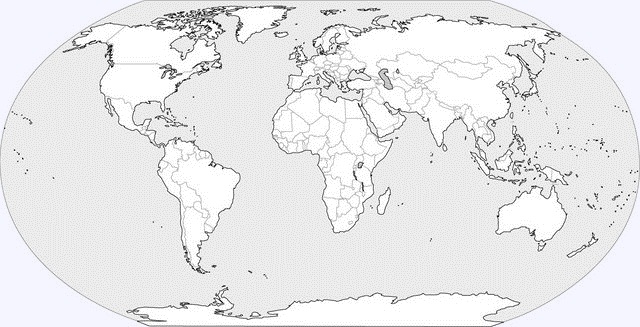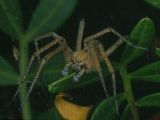|
Nombre común en ingles:
Burrowing Spiders,
Ant-Eating Spiders
Nombre común en castellano:
Se desconoce
Familias similares:
Género tipo:
Zodarion Walckenaer, 1826
Diagnosis:
Small to large araneomorph spiders with an enormous
variation of shapes; three tasal claws with teeth on paired tarsal
claws implanted on lateral side facing opposing claw; ecribellate;
entelegyne; six or eight eyes; serrula absent; cheliceral fangs very
short; anterior lateral spinnerets long; posterior spinnerets
reduced.
Caracteres descriptivos:
Caparazón:
highly variable in shape; in general oval, narrowed anteriorly (more
so in males); fovea varies from well developed and deep to poorly,
developed or absent; integument varies from entirely smooth to
densely granulate or with tiny perforations; row of strong setae in
ocular area in Cyrioctea and Leprolochus. Esternón:
usually oval or shield-shaped; in some genera with triangular
extensions corresponding to slifht concavities in coxae or
intercoxal or precoxal sclerites; sternum sometimes rebordered. Ojos:
six (Trygetus) or eight; eye size and arrangement variable: in two
or three rows (2:4:2 or 2:2:4); secondary eyes with canoe-shaped
tapetum. Quelíceros: strong with a well developed lateral
condyle; sometimes fused or separated by a membranous
inter-cheliceral triangle; fangs usually short and thick at base;
cheliceral teeth present, few or absent. Piezas bucales:
endites converging strongly; serrula absent; anteromesal scopula
present. Patas: three claws, rarely two (Hermippus); unpaired
claw often situated on onychium; paired claw with numerous teeth
inserted on lateral side facting opposing claw (in the axis in
Cyrioctea); leg formula 4123 or 4132; spination usually well
developed; digging species usually with numerous strong spines on
posterior legs; trichobothria in rows; scopulae replaced by dense
short spines in many species; femoral gland present in derived
Zodariinae. Palpo femenino:
palpal tarsus varies in shape between genera; tarsal claw usually
finely toothed to well developed and toothless; claw tends to turn
inward 30-90º. Abdomen: usually ovoid, sometimes twice as
long as wide, or higher at back than in front; scutum present in
males in some genera. Hileras:
median posterior spinnerets reduced or absent; in most genera of
Zodariinae anterior spinnerets on a common base, retractile in some
genera; anterior median spinnerets usually with one or two major
ampullate gland spigots surrounded by piriform gland spigots;
posterior median and lateral spinnerets in female often with a few
large cylindrical gland spigots; colulus reduced to a setose field. Sistema respiratorio:
two booklungs; tracheal spiracle relatively narrow; often with
sclerotized rim, situated just in front of spinnerets; leading into
four tiny tracheae or two large ones extended into cephalothorax. Genitalia:
entelegyne; epigyne variable, often a central plate with copulatory
ducts originating medially; tibia of male palp with one or several
dorsolateral apophyses; cymbium oval; subtegulum present and tegulum
complex, with several apohyses. Tamaño corporal:
2-21 mm. Color: highly variable; pale to dark brown; abdomen
usually decorated with simple pattern (spots, blotches or chevrons);
sometimes with metallic lustre.
Estatus taxonómico:
Zodariidae is one of the problematic families as far as their
placement is concerned. Although Coddington et al. (2004) place them
without argumentation in a trichotomy with Dionycha and
Amaurobioidea, we consider the family part of the Amaurobioidea
owing to the presence of alternating longitudinal bald and hairy
patches on the patellae (Thaler & Knoflach, 2004) and of hinged
hairs on some leg joints (Jocqué, 1991).
Note: According to Wunderlich
(2004), the Homalonychidae and Cryptothelidae are part of the
Zodariidae and form their own subfamilies. The former does not have
a single morphological character to support this placement.
Cryptothele, on the other hand, is most probably a member of the
subfamily Cydrelinae (eye position, basolateral extension of
endites), which will then become the Cryptothelinae.
Distribución: Tropical and
subtropical regions; few genera in Paleartctic.

Estilo de vida:
Free-living ground-dwellers or tree-living (Storenomorphinae); many
species have a specialized diet consisting of ants or termites.
Bibliografía:
-
Baehr, B.C. 2004.
Revision of the new Australian genus Holasteron (Araneae: Zodariidae):
taxonomy. phylogeny and biogeography, Mem. Old Mus. 49: 495-519.
-
Jocqué, R. 1991. A
generic revision of the spider family Zodariidae (Araneae). Bull.
Am. Mus. nat. Hist. 201: 1-160.
-
Ubick, D. & Craig,
P.R. 2005. Zodariidae. pp. 254-255 in Ubick, D., Paquín, P.,
Cushing, P.E. & Roth, V. (Eds) 2005. The Spiders of North America.
An Identification Manual. American Arachnological Society
-
Wunderlich, J. 2004.
Fossil spiders in amber and copal. Joerg Wunderlich Verlag.
Hirschberg-Leutershausen (Germany). Vol. 3 A, B, 1908 pp.
3 géneros y 46 especies presentes en la Península Ibérica:
|
| |
- A.
adonis
Jocqué & Bosmans, 2001 |
| |
- A. balnearius
Jocqué & Bosmans, 2001 |
| |
- A. histrionicus
(Simon, 1884) |
| |
- A. ungoliantae
Pekár & Cardoso, 2005 |
|
| |
- S. reticulata
(Simon, 1870) |
|
| |
- Z. affinae
(Simon, 1870) |
| |
- Z. alacre
(Simon, 1870) |
| |
- Z. alentejanum
Pekár & Carvalho, 2011 |
| |
- Z. algarvense
Bosmans, 1994 |
| |
- Z. andalusicum
Jocqué, 1991 |
| |
- Z. atlanticum
Pekár & Cardoso, 2005 |
| |
- Z. bacelarae
Pekár, 2003 |
| |
- Z. beticum
Denis, 1957 |
| |
- Z. bosmansi
Pekár & Cardoso, 2005 |
| |
- Z. cesari
Pekár, 2011 |
| |
- Z. costablancae
Bosmans, 1994 |
| |
- Z. costapratae
Pekár, 2011 |
| |
- Z. diatretum
Denis, 1935 |
| |
- Z. duriense
Cardoso, 2003 |
| |
- Z. elegans
(Simon, 1873) |
| |
- Z. fulvonigrum
(Simon, 1874) |
| |
- Z. fuscum
(Simon, 1870) |
| |
- Z. gallicum
(Simon, 1873) |
| |
- Z. gregua
Bosmans, 1994 |
| |
- Z. guadianense
Cardoso, 2003 |
| |
- Z. isabellinum
(Simon, 1870) |
| |
- Z. italicum
(Canestrini, 1878) |
| |
- Z. jozefienae
Bosmans, 1994 |
| |
- Z. lusitanicum
Cardoso, 2003 |
| |
- Z. machadoi
Denis, 1939 |
| |
- Z. maculatus
(Simon, 1870) |
| |
- Z. mallorca
Bosmans, 1994 |
| |
- Z. marginiceps
Simon, 1914 |
| |
- Z. merlijni
Bosmans, 1994 |
| |
- Z. minutum
Bosmans, 1994 |
| |
- Z. modestum
(Simon, 1870) |
| |
- Z. murphyorum
Bosmans, 1994 |
| |
- Z. pseudoelegans
Denis, 1933 |
| |
- Z. rubidum
Simon, 1914 |
| |
- Z. rudyi
Bosmans, 1914 |
| |
- Z. segurense
Bosmans, 1994 |
| |
- Z. soror
(Simon, 1874) |
| |
- Z. styliferum
(Simon, 1870) |
| |
- Z. timidum
(Simon, 1874) |
| |
- Z. vanimpei
Bosmans, 1994 |
| |
- Z. viduum
Denis, 1937 |
| |
|
 |